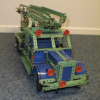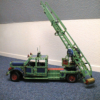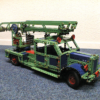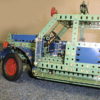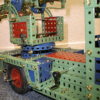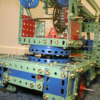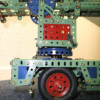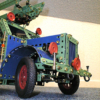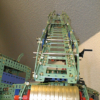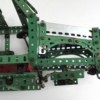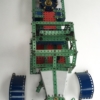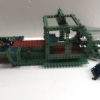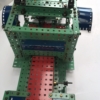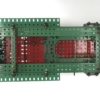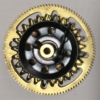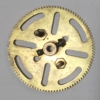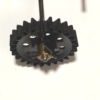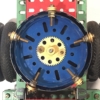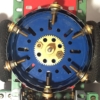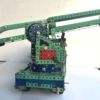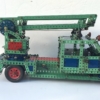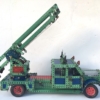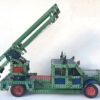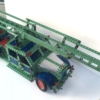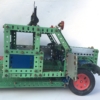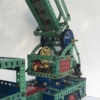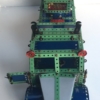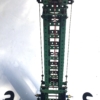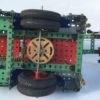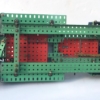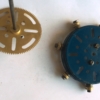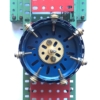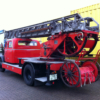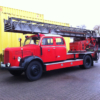MARKLIN > Models > Feuerwehrauto
The role model:
Turntable ladders on Hood chassis were from the 1920s until the 1980s, a familiar sight on German roads. The unknown had first farmer of Märklin model certainly one of the known designs based on the chassis of Magirus or Daimler-Benz in mind.
Law one of the possible models: 1952 Magirus DL. Image courtesy of the first Rhineland-Palatine Fire Department Museum in Hermeskeil. Since there are also more information about the model and other historical fire engines.
0: The model
History of the model:
Green fire engines seem strange from today’s perspective. The incorporation of the fire brigades in the police cars were green circuit but in the Nazi period – and also in the post-war period of the day. The equipment with red signal lights (instead of German blue light) was ordered in many areas of Germany in 1945 by the Western Allies.
The turntable ladder first appears in 1949 171b in Märklin instruction booklet. It is one of the larger models, whose construction we are proud owners of 105 (from 1957 in 1015 referred to), must be the biggest box of the range. The model remains in the instructions to the big boxes (14930) to 1977, the year of publication of the reordered range.
Function:
The model stands on the plan by a variety of functions:
- steering of the front axle
- Head Turn
- Head raising and lowering
- Head in and out
- The hope, then everything is working properly is deceptive …
Building the model:
As almost all the major post-war models designed without taking into account the gravity and the fire department. Therefore, the builder has the model modified in some respects – to achieve any decent results.
The builder Markus Schmidt:
“All you have to do with the turntable ladder is indeed thought beautiful, but not well designed. The roller bearings on which the ladder rests, is much too small to stand space. The crank / chain drive rotates with difficulty the manager about the axis and is on roller bearings extend just before the spin. Head and rotate around its own axis, is difficult because the conductor soars.
The extension of the conductor is functioning properly, but as the game of the sprockets is quite large, the conductor vibrates also on.
Revving the conductor, however, would not even work if not the sprockets were secured on the round plates against slipping (terminals), and the circuit would have been extended to the rear as a noticeable feature, and loaded with weights, at least about the laws of levers again put into effect. But even that is not enough: The gears would still slip through if not the axle shafts a groove would be provided. ”
The a page using this copy counterweights not correspond to the original plan, but are useful. These parts, however, are younger than building instructions, they were introduced only with the track-1 car kit 1511 into Metallbaukasten range.
The steering wheel is also used later date, until the introduction of the “orange series” there was in the Märklin range of parts not really credible steering wheel.
The cooler is being built, according to the instructions you should here trapezoidal cladding panels folding, with these quite rare parts you do not something today …
Since the biggest box 105/1015 never got added to a ball bearing, one had to rely on the somewhat shaky construction of a self annex forming roller bearing for supporting the conductor. The ball bearing turntable (11750, 11754, 11755) would certainly have been the better choice at this point.
AUTOSCALA DEI POMPIERI:
Scale girevoli dei pompieri su telaio Hood sono state, dal 1920 fino al 1980, una vista familiare sulle strade tedesche. Il realizzatore del modello Märklin aveva in mente certamente uno di questi veicoli basato su telaio Magirus o Daimler-Benz.
L’originale di questo modello dovrebbe essere il Magirus DL del 1948. L’immagine è per gentile concessione del primo Museo dei Vigili del Fuoco della Renania-Palatino in Hermeskeil.
Storia del modello:
L’autoscala girevole appare per la prima volta nel 1949 nel libretto di istruzioni 171b della Märklin. Si tratta di uno dei modelli più grandi, la cui costruzione era destinata ai fortunati proprietari della scatola 105 la maggiore della gamma. Il modello rimase nelle istruzioni delle grandi scatole (14930) fino al 1977.
Caratteristiche del modello:
Il modello ha una varietà di funzioni:
- sterzo dell’asse anteriore
- sportelli apribili
- rotazione della base della scala
- innalzamento e l’abbassamento della scala
- movimento telescopico degli elementi della scala
- MARKLIN Feuerwehrauto
- MARKLIN Feuerwehrauto
- MARKLIN Feuerwehrauto
- MARKLIN Feuerwehrauto
- MARKLIN Feuerwehrauto
- MARKLIN Feuerwehrauto
- MARKLIN Feuerwehrauto
- MARKLIN Feuerwehrauto
- MARKLIN Feuerwehrauto
- MARKLIN Feuerwehrauto
- MARKLIN Feuerwehrauto
- MARKLIN Feuerwehrauto
- MARKLIN Feuerwehrauto
- MARKLIN Feuerwehrauto
- Escape Lifting
- Escape Lifting
- Escape Lifting
- MARKLIN Feuerwehrauto
- MARKLIN Feuerwehrauto
- MARKLIN Feuerwehrauto
- MARKLIN Feuerwehrauto
- MARKLIN Feuerwehrauto
- MARKLIN Feuerwehrauto
- MARKLIN Feuerwehrauto
- MARKLIN Feuerwehrauto
- MARKLIN Feuerwehrauto
- MARKLIN Feuerwehrauto
- MARKLIN Feuerwehrauto
- MARKLIN Feuerwehrauto
- MARKLIN Feuerwehrauto
- Roller bearing
- Roller bearing
- Mercedes
- Mercedes

